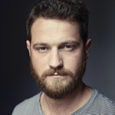In the early ’90s, when hundreds of thousands of people started to leave Kosovo as it was in the midst of the wars that ravaged former Yugoslavia, amongst them was Sislej Xhafa. But he had a different objective — art.
He was named after impressionist French painter Alfred Sisley, one of his father Xhevdet Xhafa’s favorite artists, known for his autobiographical approach to painting. In his early 20s, Xhafa arrived in London and enrolled at the Chelsea College of Arts. However, he left college soon after and went to Italy, where he started his studies at the Florence Academy of Art. This was in 1993, and for the next four years he would live in the city, exhibiting his artwork within a close circle of friends.
This changed in 1997, when Xhafa appeared before a broader public. It was then that he began his transformation into one of the most sought after contemporary artists; despite not being invited to the Venice Biennale, which is considered to be the biggest art event in the world, he managed to perform there “illegally.”
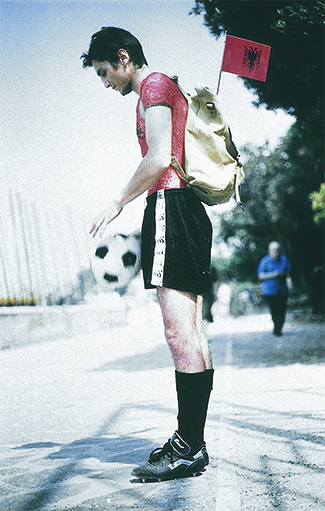
One of the first pieces that brought Sislej Xhafa to prominence was his 1997 “Albanian Clandestine Pavilion,” which he exhibited at the Venice Biennale — uninvited. Photo courtesy of GALLERIA CONTINUA, San Gimignano / Beijing / Les Moulins / Habana.
The “Albanian Clandestine Pavilion” was a piece that opposed the exclusive approach of the Biennale toward artists who come from so-called “third world” countries. It also criticized the marginalizing policies toward migrants in Western countries. Within the Biennale’s spaces, dressed in the official kit of Albania’s national football team and holding a football, Xhafa challenged Biennale guests to play against him.
In many ways, this work introduced Xhafa and his critical take as an artist. Reviews of his work would state that his performative interventions “do not only underline or present national disparities, but have been able to update the institutions he critiques.”
Two years later, Albania was invited to the Biennale for the first time. Xhafa represented the country with his piece “Casa Senza Titolo.” He represented Albania again in 2005 with his piece “Ceremonial Crying System PV,” and he also represented Italy in 2014.
In 2017, he represented Kosovo with the piece titled “Lost and Found,” as part of which he presented a wooden cabin in which there is a telephone that never rings. Through this he symbolized the expectations about missing persons from the war in 1999, and the calls that never came. Moreover, as part of this piece he also called out the names of the missing persons in the streets of Venice, accompanying it with the beating sounds of a drum.
Xhafa continuously elaborates on the complexity of contemporary societies, the identity of societies and individuals, and the subversion of traditional perceptions in general.
Since 2000, he has been living in New York. Meanwhile, amongst other places, he has exhibited his work in the Palais de Tokyo (Paris), Galleria Continua (Beijing) and the mobile Manifesta – European Biennial of Contemporary Art.
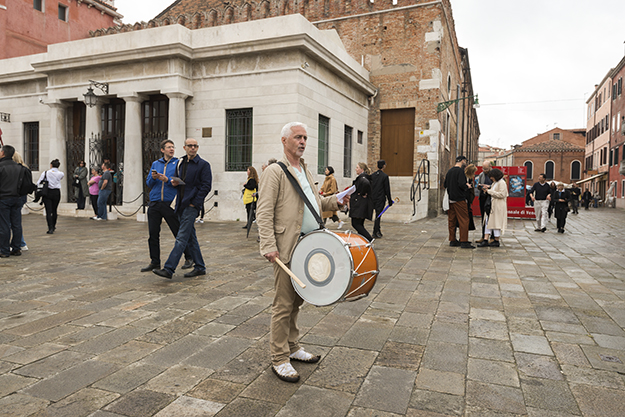
Part of his “Lost and Found” exhibition at the 2017 Venice Biennale involved beating a drum while reciting the names of missing people from the Kosovo war. Photo courtesy of the artist and GALLERIA CONTINUA, San Gimignano / Beijing / Les Moulins / Habana. Photo by: Oak Taylor-Smith.
As Kosovo celebrates its 10 year anniversary of independence this week, K2.0 discussed Xhafa’s pieces with him in retrospective, elaborating on how we can understand them in today’s global political context, especially the local one.
K2.0: Migration, the economy, ‘the legal and the illegal,’ social consequences of political developments — they have continuously been part of your artistic work. Considering these elements, is art political? What is art, to you?
Xhafa: Art is a question. I do not know the answer. Had I known the answer, I would have never made art. This analogy does not hold for politicians, because politicians are chosen by the people, and they willingly attempt to sacrifice themselves for general benefit. A politician’s job does not include asking questions, rather it is about giving answers, finding solutions and providing a vision for the country. If my work arouses people’s curiosity about a social or political issue — I am not aware of this — it means that I have raised a delicate and sensitive issue.
This year, Kosovo marks its 10th anniversary. If you were to consider Kosovo’s independence to be a work of art, how would you evaluate it?
An empty glass. No water.
"I do not perceive Kosovo’s politicians as individuals. On the contrary, I see them as a collective group in a upside down zoo."
An empty glass could still be considered to be artistic, could it not? By equating “the empty glass” with “independence,” are you implying that the glass exists but it does not fulfil its duty as it is empty?
Today, the glass is empty, but it can be filled. The water is a metaphor for freedom and for the curiosity that in recent times has been kidnapped in the name of freedom, as a result of the responsibility and creativity that our politicians lack.
In 1997 you realized a performance at the Biennale in Venice. You called it “Albania’s Clandestine Pavillion.” According to you, this was a form of opposing the Biennale for the lack of space it offered for artists coming from countries like Albania, countries in Eastern Europe or Asia, and the like. Seeing that Kosovo is facing difficulties regarding representation in international institutions, do you think Kosovo should copy you and create a “clandestine pavilion” at the UN and perform there?
That piece was performed in 1997 and today we are in 2018. Today we can present Kosovo’s absence in the UN in a unique and original way. That is the challenge. Money is not the only thing that makes the world go round. It is also about ideas and creative minds. Today, the world of old and overused templates has ended. Creativity and innovation is sought in every field.
In the art piece titled “Silvio,” a democratically elected politician uses all of his financial and media powers to stay in power. For this piece you used the figure of former Italian Prime Minister Silvio Berlusconi, but you refused to exhibit the piece in Italy. What would be the model of the Kosovar “Silvio,” one which you would never exhibit in Kosovo?
Kosovo’s politicians span a horizontal line that includes arrogance and a lack of vision and ethics. Massive corruption in the name of freedom is Kosovo’s biggest tragedy post independence. I do not perceive Kosovo’s politicians as individuals. On the contrary, I see them as a collective group in a upside down zoo. This zoo is maintained by screaming and eating anything that comes before them. They do it in packs, and when they run out of food, they will eat one another.
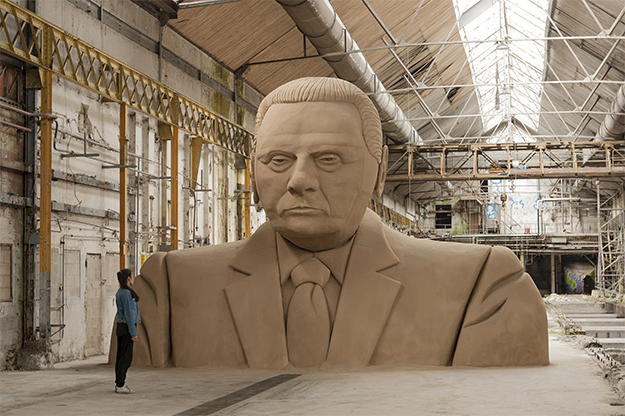
Xhafa refused to exhibit his piece “Silvio,” a reference to former Italian Prime Minister Silvio Berlusconi, in Italy. Photo courtesy of GALLERIA CONTINUA, San Gimignano / Beijing / Les Moulins / Habana. Photo by: Oak Taylor-Smith.
It seems there is a similarity between three of your earlier pieces and some developments in the country. I want to briefly summarize these three pieces: Your performance at a train station, where you said that it portrays the movement of people and the way they are treated as merchandise, and where you highlighted that the station’s acoustics mimic the way Wall Street functions; then it was the search for a job in the mountains, which you said represents “today’s economic absurdity”; and the two-sided wall with one door which you built in Torino, above which you wrote “Employment Center,” portraying the illusion of change, namely that even when you go through a door, you see that you are still in the same position.
These pieces were made years ago. Independence is like a door that offered Kosovars something, but after they entered it, they saw that they were still in the same place. Afterwards, they took the ‘train’ to look for a job in European countries, but it was like ‘looking for a job in the mountains’.’ You have continuously said that your pieces only ask questions. But can pieces of art also have a dimension of prophecy within them?
Today we live with the trauma of post-intelligence. Absurdity and idiocy are priorities. It is a symbiosis of time in which the artwork invents its own time.
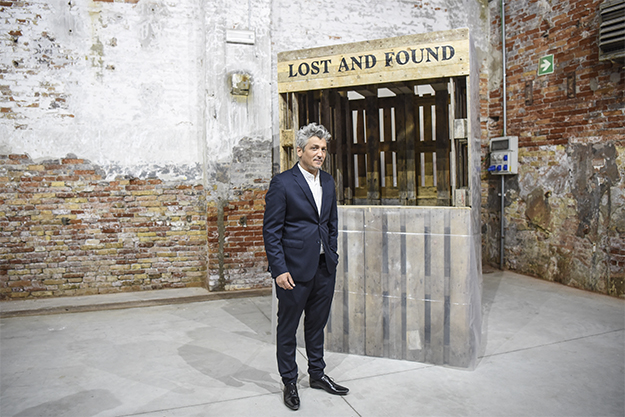
Xhafa, says that he “cannot be indifferent in the face of injustice,” with his pieces challenging the audience to think more deeply on sensitive topics. Photo: Armend Nimani.
You represented Kosovo in the Venice Biennale with the piece “Lost and Found,” which focused on persons who disappeared in the war. Institutions have been criticized for not engaging enough in this regard. What pushed you to deal with the issue of missing persons, and what differs in the way in which an artist deals with this kind of subject, which is sensitive and related to the work of institutions?
I cannot be indifferent in the face of injustice. This issue is following us like a shadow and we must be concerned. The power of art is not local, national or geographic. The challenge of art is a time in a global sphere.
You are yet to exhibit any artwork in Kosovo because, as you’ve said, you are yet to receive a serious offer. On the other hand, you have highlighted the importance of the space in which you exhibit your art. How do you see Kosovo as a space for creating and exhibiting art?
It is a challenge. Irrationality creates new tendencies. Kosovo was a big inspiration for creators from different generations. Injustice, violence, discrimination and intellectual hunger are the most important inspirations for a person who creates. Fresh artistic forms and irrational ideas are the future. It is difficult, challenging and requires bold individual steps.
In one of your statements, you said that the key issue in our society is “institutional prostitution.” What is the relationship between the artist and institutions?
Nathan Coley’s piece “A place beyond belief” [2012, financed by the National Gallery of Kosovo and installed in the university campus] is proof that confirms cultural prostitution and aesthetic placement.
When victimization itself is held up sky-high, the victim starts to victimize themself.
I am not talking about the artwork itself, but rather about the selection process. Kosovo employs people from all over the world without public competition and transparency, without local or international juries, with the objective of promoting the country. Kosovo engages people to show the world that Kosovo is progressing fast. This is a media farce. It is a facade, a lack of intellect that has produced mediocracy.
Is power corrupted by artists or are artists corrupted by power?
Power corrupts artists by giving them grants. A concrete example is the Cinematographic Center of Kosovo. Artists that do not receive grants for realizing their scripts start writing and speaking against the government in interviews. The very same artists shut their mouths and disappear from public opinion once they receive the grants.
The path of an artist is solitary, very poor and very, very long. But it [the path of the artist] is encouragement and a stimulation for hunger, for not giving in to compromise, for intellectual and decisive autonomy.
Your performance in the Venice Biennale in 1997 is what brought you before a big audience, what made you famous. In this performance, you were “clandestine,” whereas two years later, you represented Albania — and later Kosovo — in the very same place. Does this mean that after ’97, Sislej Xhafa was ‘legalized’ in his artistic performances?
The “Albanian Clandestine Pavillion” legalized the Biennale. The consequences are unforeseeable. The “Albanian Clandestine Pavillion” was evaluated by critics as an original discovery of a tale about a country and people such as us.
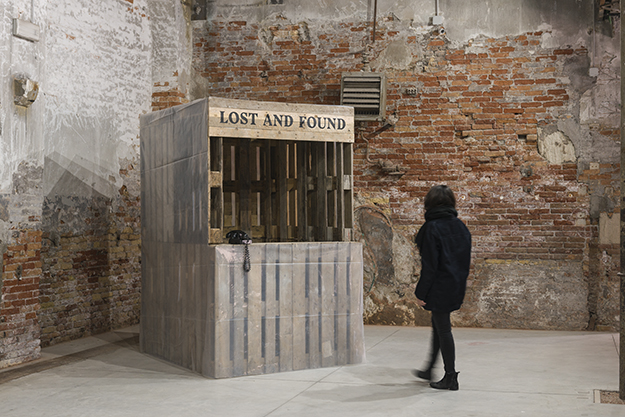
Having previously represented both Albania and Italy at the Venice Biennale, Xhafa represented his native Kosovo in 2017. Photo courtesy of GALLERIA CONTINUA, San Gimignano / Beijing / Les Moulins / Habana. Photo by: Oak Taylor-Smith.
What kind of people are we?
We are people built by a sense of victimization. Historically, we have been peaceful, we have never attacked anyone, and we helped the Jews during World War II. But the truth is that we did not have the intellectual capacity to build our state, and we were used by the bigger powers for their objectives.
This victimization reached a point at which we changed our identity for social and political objectives; thus we are the last ones to have our own state in the Balkans.
We did not attack anyone because we did not have the political capacity. When victimization itself is held up sky-high, the victim starts to victimize themself.
Art is the only power to transform the aspect of the victim into a magical and unique experience. It creates an attitude and gives hope and vision for the future.
At the turn of the century, English artist Martin Creed realized his piece “Everything is Going to Be Alright.” Years later, as a response to this, you exhibited your piece “Nothing Will Be Alright” in Belgium. Kosovo is starting its second decade as an independent state. Will “nothing be alright” or will “everything be alright” in this decade?
Hope as a means of propaganda is (something) contemporary. Kosovo and its lands are a centuries-old sacrifice — in the collective and individual sense — for being free and independent. Freedom is a practice, not an ideology. Kosovo’s people have consumed a lot of history and have experienced a lot of suffering. Now and in the past, with politicians who lack vision and responsibility, with a political and economic sector that lacks creativity, with unforeseeable consequences, Kosovo, as an independent and sovereign state, has become pale in the eyes of its citizens — and these “patriots” are to blame.
So Kosovo’s independence is hope raised in the form of propaganda?
Give me one example of a factory in Kosovo that produces a unique, functional product that is designed to compete in the region and the world and that employs at least 200 people! In the last 10 years we have had some prime ministers, hundreds of ministers and thousands of deputy ministers who were portrayed as “very, very wise mavericks.” Billions of Euros were spent on them, and today our bus station is full of young people, who are waiting for the ideal moment to migrate and leave the country. Is this the Kosovo for which we have sacrificed ourselves? Is this the Kosovo you want? Reality is very sad.K
Feature image: Courtesy of GALLERIA CONTINUA, San Gimignano / Beijing / Les Moulins / Habana.
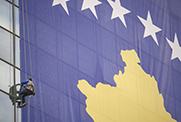
Back to Kosovo X Monograph







